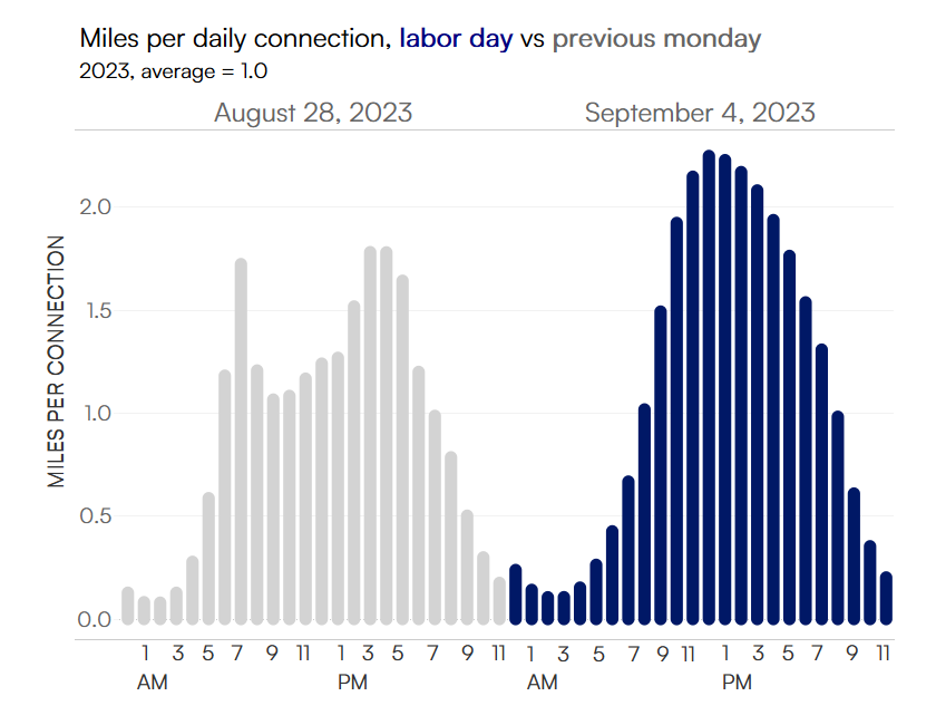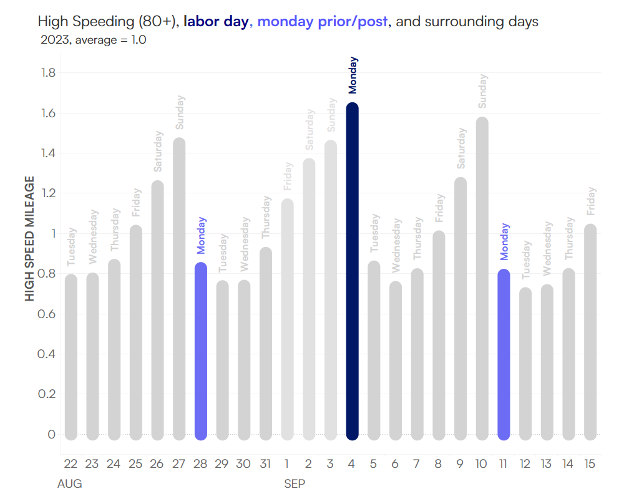New Year’s Eve driving behavior trends 2025 Read article


While summer doesn’t end until September 22nd this year, Labor Day weekend often marks the unofficial end of summer as the last federal holiday of the season. To commemorate, people often treat the long weekend as “the last hurrah,” squeezing in one final barbecue, beach outing, or vacation.
To close out our summer road series, which started with Memorial Day, we once again dove into our massive dataset to uncover trends around driving patterns and behaviors in the U.S. This time, we looked at the weeks surrounding Labor Day weekend from 2021 – 2023.
If you’re planning to hit the road, here are three trends to know to travel safely and efficiently over the long weekend.
During Labor Day weekend, expect more people to be on the road. When compared to the surrounding, non-holiday weekends, the number of average miles driven per person is higher. Much of this increase comes from the 9% uptick in miles driven the Friday leading into the weekend and the 23% increase in miles driven on Labor Day.

On the holiday itself, traffic patterns look like a weekend. It’s more dispersed throughout the day compared to a normal Monday, which sees commuting spikes in the morning and late afternoon/evening. In fact, roads on the holiday were busiest between 10 a.m. and 4 p.m. last year – with a peak at noon which saw 81% more mileage compared to the Monday before.
Key takeaway? If you’re planning to hit the road on Labor Day, you may want to avoid traveling midday to avoid peak travel times.
Looking at Labor Day over the past three years, driving at high speeds sees the most prominent increase for a risky driving behavior, as it’s almost two times higher than what we see on non-holiday Mondays. Additionally, Friday and Saturday observe an increase in high-speed mileage over Labor Day weekend.

In a recent survey of 1,000 licensed U.S. drivers, Arity found that less than half (42%) believe speeding is “extremely unsafe.” However, it’s vital to keep in mind that speeding makes accidents more likely and more severe.
Key takeaway? Be cautious of other drivers traveling at high speeds throughout Labor Day weekend, and avoid partaking in this risky driving behavior to protect you, your loved ones, and others on the road.
We see a decrease in both distracted driving (5%) and hard braking (7%) over Labor Day weekend. This decline is most pronounced on Labor Day with an average 17% decrease in both behaviors.
However, with over 1.5 trillion miles of driving data collected and analyzed, Arity has a unique historical understanding of driving behaviors, risk, and outcomes. And distracted driving, at any level, is inherently dangerous and contributes to the driving safety crisis.
Key takeaway? Even though levels of distracted driving and hard braking are lower over Labor Day weekend compared to non-holiday weekends, it’s still important to be cautious of these behaviors as they can create risk on our roads.
Although Labor Day marks the end of our summer road series, Arity is continually generating insights to help people, businesses, and government agencies navigate shifts in driving patterns and behaviors.
If you’re ready to learn more, download our latest data report to explore the rise in dangerous driving since COVID-19.
Arity’s multi-source dataset with more than 40 million active connections includes anonymized and aggregated driving behavior data collected through consumer mobile apps, insurance telematics, and on-board device (OBD) programs.
Because the data is from multiple insurance and non-insurance sources and is not solely reflective of any Arity affiliate companies or any other particular industry or source, we really get a sense of how people are moving, where they are going, when, and how. Arity is connected to millions of U.S. drivers, so we have a credible representation in every state and demographic (e.g., families, single vehicles, rural, cities).
Keep in mind that although a majority of the trips Arity collects are personal trips, we have the capability to decipher between personal trips, gig driving, and non-driving impacts.
Because Arity collects various driving behaviors within a trip, we can evaluate trends such as speeding, braking, acceleration, phone handling, and the time of day someone drives. Additionally, fueled by the largest telematics dataset tied to auto insurance claims, we can more accurately predict the impact of shifting trends in the dangerous driving behaviors that we described in this report.